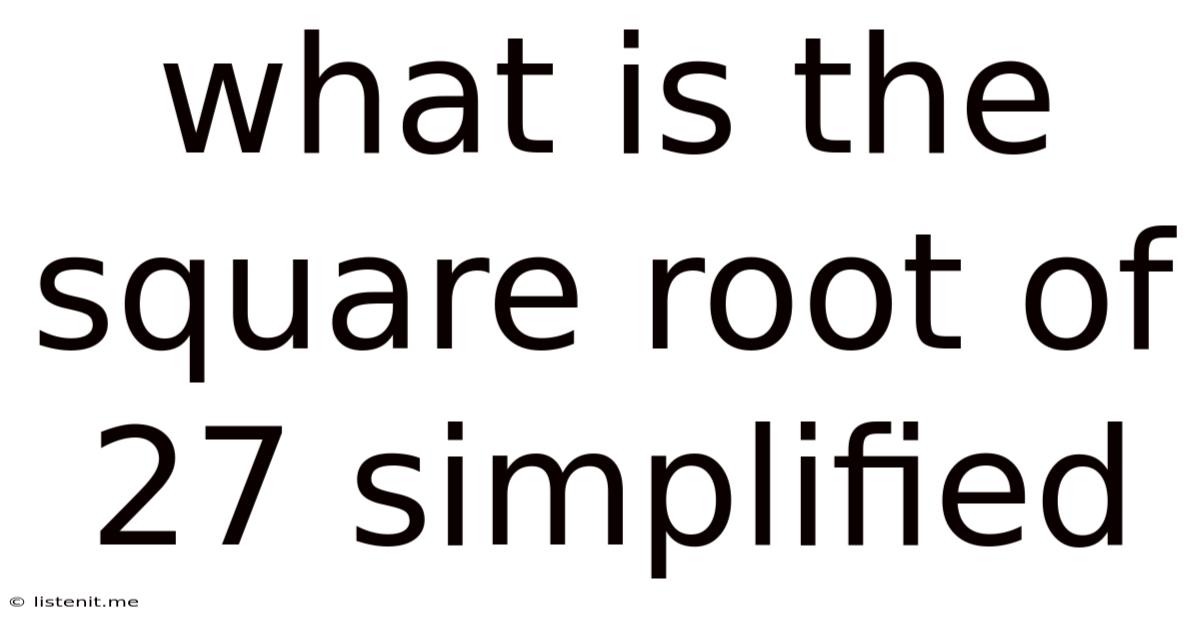What Is The Square Root Of 27 Simplified
listenit
May 09, 2025 · 4 min read

Table of Contents
What is the Square Root of 27 Simplified? A Comprehensive Guide
The question, "What is the square root of 27 simplified?" might seem straightforward, but it opens the door to a deeper understanding of square roots, prime factorization, and simplifying radicals. This comprehensive guide will not only answer the question but also equip you with the knowledge to tackle similar problems with confidence.
Understanding Square Roots
Before diving into the simplification of √27, let's refresh our understanding of square roots. The square root of a number is a value that, when multiplied by itself, equals the original number. For example, the square root of 9 (√9) is 3 because 3 x 3 = 9.
However, not all square roots are whole numbers. Many numbers, like 27, do not have a whole number as their square root. This is where simplification comes into play. We aim to express the square root in its simplest radical form.
Prime Factorization: The Key to Simplification
The core technique for simplifying square roots lies in prime factorization. Prime factorization is the process of breaking down a number into its prime factors—numbers that are only divisible by 1 and themselves (e.g., 2, 3, 5, 7, 11, etc.).
Let's apply prime factorization to 27:
- 27 is divisible by 3: 27 = 3 x 9
- 9 is also divisible by 3: 9 = 3 x 3
Therefore, the prime factorization of 27 is 3 x 3 x 3, or 3³.
Simplifying √27
Now, we can use the prime factorization to simplify √27:
-
Rewrite the square root using prime factors: √27 = √(3 x 3 x 3)
-
Identify pairs of identical factors: Notice that we have a pair of 3s.
-
Take out the pairs: For every pair of identical factors under the square root, you can bring one factor outside the square root. In this case, the pair of 3s becomes a single 3 outside the square root.
-
Simplify: This leaves one 3 remaining under the square root.
Therefore, the simplified form of √27 is 3√3.
Visualizing the Simplification
Imagine you have 27 small squares. You want to arrange them into a larger square. You can arrange 9 squares (3 x 3) into a 3x3 square. That's where the '3' outside the square root comes from. You're left with 18 more squares that can't form a perfect square. That's represented by the '√3'.
Working with Other Square Roots: A Step-by-Step Guide
Let's solidify our understanding by simplifying other square roots using the same method.
Example 1: Simplifying √48
-
Prime Factorization: 48 = 2 x 2 x 2 x 2 x 3
-
Rewrite: √48 = √(2 x 2 x 2 x 2 x 3)
-
Identify Pairs: We have two pairs of 2s.
-
Simplify: Each pair of 2s becomes a 2 outside the square root. The remaining 3 stays inside.
-
Result: √48 simplifies to 4√3
Example 2: Simplifying √75
-
Prime Factorization: 75 = 3 x 5 x 5
-
Rewrite: √75 = √(3 x 5 x 5)
-
Identify Pairs: We have a pair of 5s.
-
Simplify: The pair of 5s becomes a 5 outside the square root. The 3 remains inside.
-
Result: √75 simplifies to 5√3
Example 3: Simplifying √108
-
Prime Factorization: 108 = 2 x 2 x 3 x 3 x 3
-
Rewrite: √108 = √(2 x 2 x 3 x 3 x 3)
-
Identify Pairs: We have a pair of 2s and a pair of 3s.
-
Simplify: Each pair becomes a factor outside the square root. One 3 remains inside.
-
Result: √108 simplifies to 6√3
Beyond Simplification: Adding and Subtracting Radicals
Once you've mastered simplifying radicals, you can move on to more advanced operations like adding and subtracting them. The key here is to simplify each radical first and then combine like terms.
Example: Simplify 2√12 + √27 - 3√3
-
Simplify each radical:
- √12 = √(2 x 2 x 3) = 2√3
- √27 = √(3 x 3 x 3) = 3√3
-
Substitute: 2(2√3) + 3√3 - 3√3
-
Combine like terms: 4√3 + 3√3 - 3√3 = 4√3
Therefore, 2√12 + √27 - 3√3 simplifies to 4√3.
Applications of Square Roots
Understanding square roots and their simplification isn't just an abstract mathematical exercise. It has numerous applications across various fields, including:
-
Geometry: Calculating the length of the diagonal of a square or rectangle. The Pythagorean theorem extensively uses square roots.
-
Physics: Solving problems involving velocity, acceleration, and energy.
-
Engineering: Designing structures and calculating dimensions.
-
Computer graphics: Generating images and animations.
Conclusion
Simplifying the square root of 27, or any square root for that matter, is a fundamental skill in mathematics. Through prime factorization and the methodical extraction of paired factors, we can express these roots in their simplest and most efficient forms. This understanding extends to more complex operations and finds practical applications across a range of disciplines. By mastering this core concept, you build a strong foundation for tackling increasingly challenging mathematical problems. Remember to practice regularly to solidify your understanding and build confidence in working with square roots.
Latest Posts
Latest Posts
-
Elements With The Same Atomic Number But Different Atomic Masses
May 09, 2025
-
The Si Unit For Pressure Is
May 09, 2025
-
How To Write In The 3rd Person For An Essay
May 09, 2025
-
Standard Enthalpy Of Formation Of Methane
May 09, 2025
-
Find The Quotient And Remainder Using Synthetic Division
May 09, 2025
Related Post
Thank you for visiting our website which covers about What Is The Square Root Of 27 Simplified . We hope the information provided has been useful to you. Feel free to contact us if you have any questions or need further assistance. See you next time and don't miss to bookmark.